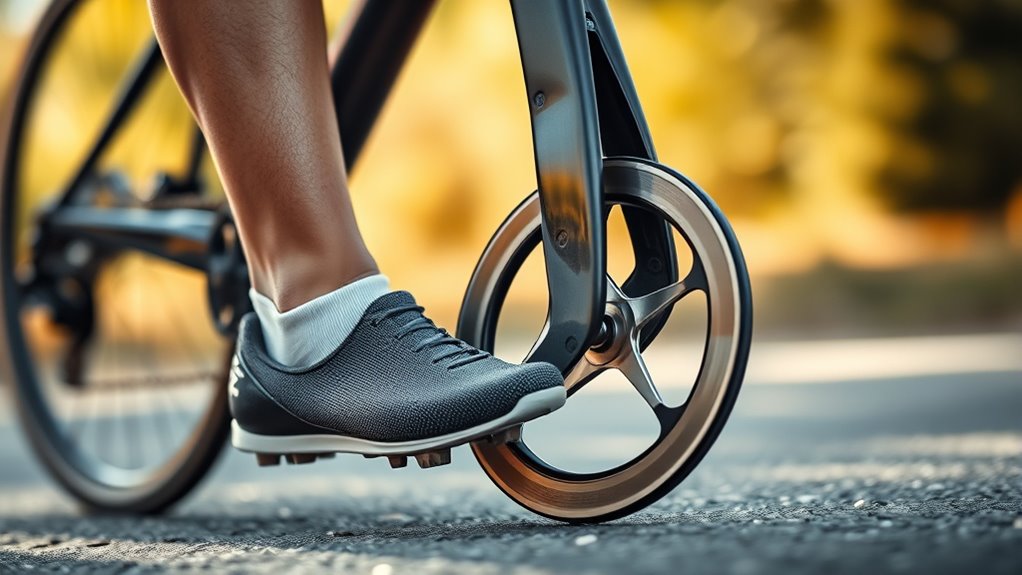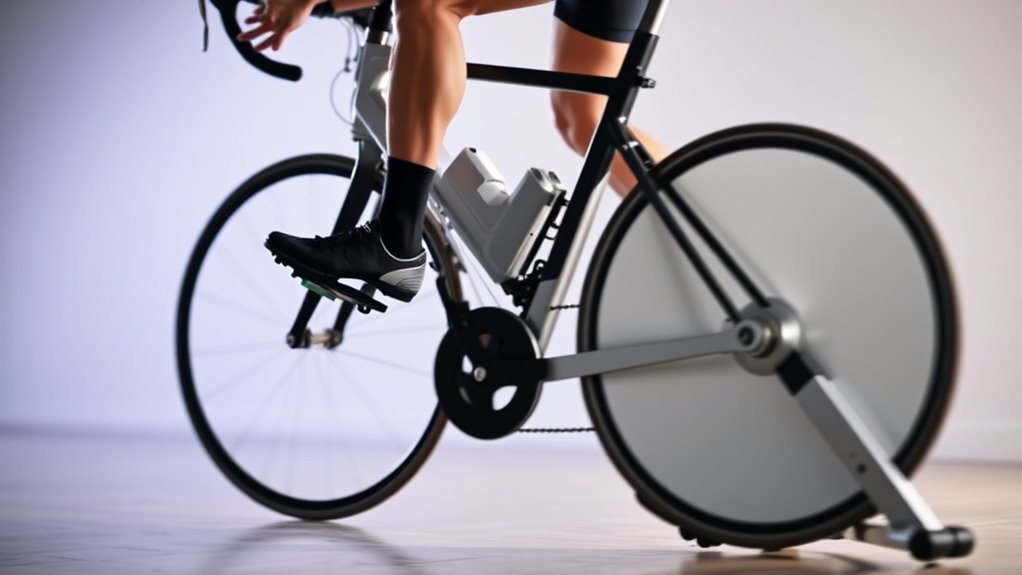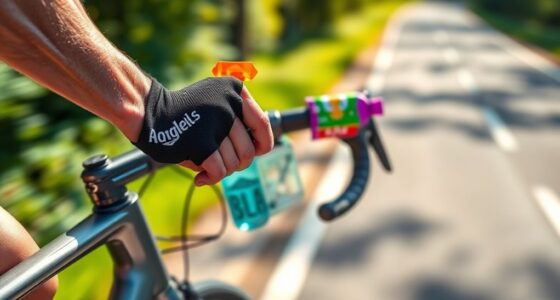To improve pedal stroke efficiency, focus on steady cadence drills around 80-100 RPM using a bike computer or cadence sensor. Practice single-leg pedaling to identify and correct asymmetries, while emphasizing smooth force application throughout each stroke. Incorporate pull-up drills to engage hamstrings and calves, ensuring consistent power. Paying attention to your force during different pedal phases helps eliminate dead spots. Keep working on these techniques, and you’ll unleash better efficiency on every ride.
Key Takeaways
- Incorporate single-leg pedaling drills to identify and correct asymmetries in force application.
- Practice steady cadence maintenance with a focus on smooth, consistent power throughout the pedal stroke.
- Use pull-up exercises to actively engage hamstrings and calves during the upstroke for improved efficiency.
- Monitor and adjust cadence regularly with a bike computer or cadence sensor for optimal, sustainable pedaling rates.
- Focus on even force distribution throughout the pedal cycle, avoiding dead spots at the top and bottom.

Improving your pedaling efficiency can make a significant difference in your cycling performance, whether you’re a casual rider or a competitive athlete. One of the key areas to focus on is cadence optimization, which involves finding the ideal pedaling rate that allows you to sustain effort while minimizing fatigue. When you work on cadence, you’re fundamentally training your muscles and nervous system to work together more effectively, leading to smoother, more consistent power output. As you refine your cadence, pay close attention to how force application varies throughout the pedal stroke. Consistent and well-timed force application ensures you’re not wasting energy during parts of the pedal cycle where power isn’t needed, such as the top or bottom of the stroke.
To start improving, incorporate drills that emphasize maintaining a steady cadence. Use a cadence sensor or a bike computer to monitor your revolutions per minute (RPM). Aim for a cadence that feels natural yet slightly challenging—often around 80-100 RPM for most riders—and practice riding at this consistent rate. As you become more comfortable, experiment with slight variations to identify what cadence produces the smoothest, most efficient pedal stroke for you. During these drills, focus on force application by consciously engaging your glutes, quads, and hamstrings at different points in the pedal cycle. The goal is to apply force evenly throughout the stroke, avoiding dead spots where power drops off.
Maintain a steady cadence around 80-100 RPM and focus on even force application for more efficient pedaling.
Another effective drill involves single-leg pedaling, which isolates your force application and helps you identify inefficiencies. By pedaling with one leg at a time, you can see how effectively you’re transferring power through each phase of the stroke. This drill encourages you to consciously engage your muscles and improve force application symmetry. It also highlights areas where you might be wasting energy or applying force inconsistently. As you alternate legs, keep your cadence steady and focus on smooth, controlled movements, ensuring each leg contributes equally to your overall power output.
You can also enhance your pedal stroke by practicing “pull-up” drills, where you consciously focus on pulling up with your hamstring and calf muscles during the upstroke. This not only helps optimize your force application but also smooths out your pedal stroke, making your power delivery more consistent. Incorporating muscle engagement strategies can further refine your technique and boost efficiency. Remember, the key to these drills is deliberate practice—by paying attention to cadence and force application, you gradually develop muscle memory that carries over into your regular rides, resulting in more efficient, less tiring cycling. Over time, these improvements will translate into increased speed, endurance, and overall riding enjoyment.
Frequently Asked Questions
How Often Should I Perform Pedal Stroke Drills Weekly?
You should perform pedal stroke drills about two to three times a week, depending on your training schedule. Keep each drill session around 15 to 20 minutes to maximize benefits without causing fatigue. Consistent training frequency helps improve your pedal efficiency, while proper drill duration guarantees you stay focused and avoid burnout. Incorporate these drills into your routine regularly to develop smoother, more powerful pedaling.
Can Beginners Benefit From Pedal Stroke Efficiency Drills?
Yes, beginners can benefit from pedal stroke efficiency drills. These drills help you understand how gear ratios and your cycling posture influence power transfer and smooth pedaling. As a beginner, practicing these drills regularly improves your technique, making your rides more comfortable and efficient. Focus on maintaining proper cycling posture and experimenting with gear ratios to develop better pedal control, ultimately enhancing your overall cycling performance.
What Equipment Is Necessary for Effective Drills?
You need minimal equipment for effective drills—just your bike, a bike trainer, and a cadence sensor. The trainer keeps your focus steady, while the cadence sensor tracks your pedaling speed. Together, they help you identify inefficiencies and improve your technique. With these tools, you can practice consistently, monitor progress, and fine-tune your pedal stroke, making your cycling smoother and more powerful every time you ride.
How Long Before I See Improvements in Cycling Performance?
You’ll notice improvements in your cycling performance within a few weeks, especially if you focus on training consistency. As you work on your cycling biomechanics through regular drills, you’ll develop smoother pedal strokes and better efficiency. Keep at it, stay disciplined with your training schedule, and you’ll see progress faster. Remember, consistent effort and attention to technique are key to releasing your full cycling potential.
Are There Specific Drills for Different Cycling Disciplines?
Yes, there are specific drills tailored for different cycling disciplines. Incorporate cross discipline techniques to improve overall skills and promote training adaptation. For example, track cycling might focus on sprint drills, while mountain biking emphasizes technical handling. These targeted exercises help you adapt to the unique demands of each discipline, enhancing performance. Consistently practicing these drills guarantees you develop the necessary strength, coordination, and efficiency for your specific cycling discipline.
Conclusion
By consistently practicing pedal stroke efficiency drills, you may discover that smooth, circular pedaling not only boosts power but also reduces fatigue. Some experts argue that perfecting your pedal stroke can lead to more sustainable cycling, challenging the idea that brute strength alone wins races. Embracing these drills might just release a more efficient, enjoyable ride, proving that technique often trumps raw effort. So keep refining your form—your legs will thank you, and your performance could considerably improve.









